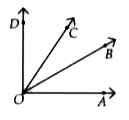Which of the following statements are true (T) and which are false(F) (i) Angles forming a linear pair are supplementary. (ii) If two adjacent angles are equal, then each angle measures 90∘.. (iii) Angles forming a linear pair can both the acute angles. {iv) If angles forming a linear pair are equal, then each of these angles is of measure 90∘..
(i) True.(ii) False. It can be possible if they are a linear pair.(iii)False. In a linear pair, if one is acute, then the other will be obtuse(iv)True.
Topper's Solved these Questions
Similar Questions
Which of the following statements are true (T) and which are false(F) (i) Angles forming a linear pair are supplementary. (ii) If two adjacent angles are equal, then each angle measures 90∘.. (iii) Angles forming a linear pair can both the acute angles. {iv) If angles forming a linear pair are equal, then each of these angles is of measure 90∘..
View SolutionTwo angles forming a __________ pair are supplementary.
View Solution
Knowledge Check
If the angles of a linear pair are equal, then each angle is _____
A30∘B45∘C60∘D90∘If the angles of a linear pair are equal, then each angle is _____
A30∘B45∘C60∘D90∘Which of the following pairs of angles are not adjacent angles?
 A∠AOB,∠BODB∠BOC,∠AOCC∠COD,∠AOCD∠BOC,∠AOB
A∠AOB,∠BODB∠BOC,∠AOCC∠COD,∠AOCD∠BOC,∠AOB
State whether the statements are True or False.
Two angles making a linear pair are always supplementary.
View SolutionOne of the angles forming a linear pair is an acute angle. What kind of angle is the other?
View SolutionCan two acute angles from a linear pair?
View SolutionOne of the angles forming a linear pair is an obtuse angle. What kind of angle is the other?
View SolutionWhich of the following pairs of angles are supplementary ?
View Solution
